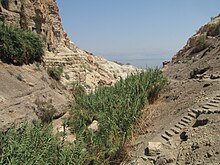Wadi Sdeir
The Wadi Sdeir (Hebrew Nachal David ) is a wadi in Israel that runs in a west-east direction . It flows into the Dead Sea north of En Gedi . The Nachal Arugot is the other river at En Gedi.
The stream is fed by a waterfall above the valley. The amount of water carried depends strongly on the season. In summer the stream is only a small trickle with a few pools of water in which tourists can swim.
Archaeological finds
As early as 1905, the German engineer GD Sandel was led by Beduins to the Cave of the Pool . He reports that he saw complete jugs at the entrance. During the discovery of the Dead Sea Scrolls in 1952, Bedouins also found fragments in Wadi Sdeir. They probably come from the Cave of the Pool , as this is the only cave in Wadi Sdeir in which other remains from the time of the Bar Kochba uprising were found. The four documents were later purchased. No. 1 consists of three fragments of a leather scroll with text from the Book of Genesis . In No. 2 the dating to the 2nd Adar of the year three of Israel's liberation , i.e. the winter of 134 AD, is of importance.
Further surveys and expeditions took place in 1958 under the direction of Yohanan Aharoni - the jugs from 1905 were no longer to be seen - and in 1960 and 1961 under Nahman Avigad . The Cave of the Pool was excavated. The cave is about 33 m deep. The water basin is partly carved out of the rock, partly constructed and plastered. It has a capacity of 12 m 3 . In addition to finds from the Copper and Iron Ages , remains from the Roman period were found, including arrowheads, combs, glass vessels and two coins, one from the year 127 from Tire , the other from the third year of the Bar Kochba uprising.
Grave caves have also been found near the mouth of the Dead Sea. The results of Yigael Yadin's excavation are unpublished, but it is known that a wooden coffin and numerous bones were discovered in a cave. Because of the pottery, the graves can be assigned to the Hasmonean period . N. Avigad discovered another six grave caves, also with some wooden sarcophagi. Gideon Hadas found a last grave cave in 1987. It contained a sarcophagus and a bronze bell. Hadas found similar tombs in the Nachal Arugot . Overall, the graves resemble family graves from the Second Temple period, as found in Jerusalem or Jericho, while no family graves are known from Qumran .
literature
- Nahman Avigad: Expedition A . In: Israel Exploration Journal 11 (1961), 6-10, panels 2-3.
- Nahman Avigad: Expedition A - Naḥal David . In: Israel Exploration Journal 12 (1962), 169-183, panels 15-22.
- Hanan Eshel : Sdeir, Wadi . In: Encyclopedia of the Dead Sea Scrolls , ed. LH Schiffman, JC VanderKam . Oxford 2000, 851-852.
- Gideon Hadas: Nine Tombs of the Second Temple Period at 'En Gedi . In: Atiqot 24 . Jerusalem 1994.
Web links
Coordinates: 31 ° 28 ′ 21 ″ N , 35 ° 22 ′ 53 ″ E


